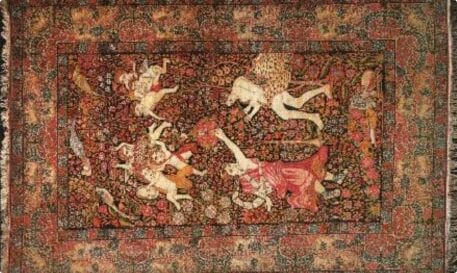White Mountains of Vafs, home to various Iranian tribes, stand tall between Hamadan and Markazi provinces in Iran (Persia). Vafs area is attributed to the Tat people, Lurs, and some Turkic tribes, amongst which Bozchalu and its famous Bozchalu rug are well remembered.
Bozchalu is an old Turkic clan. Hulagu Khan (reign: 1256-1265) settled once in the northwest of his Ilkhanate of Persia. After a while, they moved from there to Caucasian territories of the Safavid Empire by Shah Abbas the Great (reign: 1588-1629).
Today in Georgia, this group of Bozchalues (known as Bordjalou) has its type of rugs. That follows their Turkic origins of patterns, design, and structure.
But those Bozchalu rug weavers who remained in Iran made it similar to their neighboring areas: Persian Herati designs with Hamadan’s weave structure and American Saruq designs influenced by neighboring Farahan and Arak.


Technical Aspects and The Structure of Bozchalu Rug
The Bozchalu Rug [also known as Borchalu and Borchaly] is mostly woolen, single-weft, and woven with the symmetrical/Turkish knot on cotton warps and wefts. This structure is known as Hamadan, and because of that, Bozchalu pieces are categorized as Hamadan.
For piling, Bozchalu weavers use relatively thick wool. The neat weave of the area resulted in durable antique and semi-antique pieces as well as new products. Bozchalu rug weavers produce all sizes, including both rug and carpet sizes.


Dyeing and Painting of Bozchalu Rugs
Most Bozchalus are on red grounds, but one could also find blue and creams. That is true about both Herati (Mahi) and American Saruq designs.
Madder’s root from Zagros nature brings shades of red to the Bozchalu palette, which has a reputation for lighter shades.


Designs and Patterns of the Bozchalu Rug
Bozchalu villages (Khumajin and Kumbazan) are sources for two groups of designs: American Saruq and traditional Mahi (Herati) with central medallion and corners.
American Saruqs got their name after a western company that established weaving workshops around Arak. Their floral patterns influenced the area in the late 19th century. Such designs also have central medallions surrounded by wavering sprays of flowers.


Are you now interested in these fantastic Oriental rugs? Head over to our website and discover more than 10,000 top-quality Oriental rugs that have hand-picked for you from all over the world. You could count on our On-Approval Policy and Buying Assistance to make sure you’re gonna find the right rug for your sweet home that perfectly fits your style and budget.
For more info and no-obligation quotes, we’re just one simple call away!

